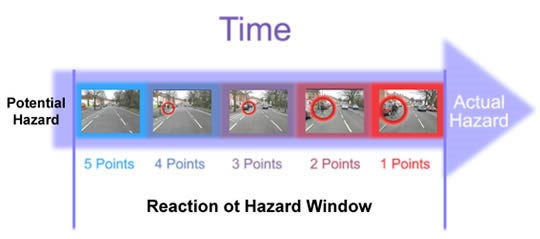

Centre for the Research on Mind, Brain and BehaviourĮmail: C., Padilla J.L., Roca J., Benítez I., García-Fernández P., Estévez B., López-Ramón M.F. It also enjoyed the disinterested collaboration of the ‘Victoria y Luna’ driving school in Granada, and the Genil driving school in Ogíjares, both of which provided students for the survey.ĭepartment of Experimental Psychology, University of Granada This project has been funded by the General Traffic Office and the CEI-Biotic at the University of Granada. These instructive comments guide participants, and provides them with relevant information on where they must focus their attention to recognise and prevent danger. Researchers also found empirical data which suggests that training based on instructive comments improve the driver's danger perception skills on the road, even in brief training sessions (8 minutes).

they do not as frequently take evasive action before potential traffic dangers).
#DRIVING HAZARD PERCEPTION TEST 2014 DRIVERS#
They also display more risk-taking attitudes and responses than non-reoffending experienced drivers (i.e. they acknowledge less frequently potentially dangerous situations as dangerous. This research has also established that new and reoffending drivers are more prone to distraction than non-reoffending, experienced drivers.Īpprentice, new and reoffending drivers (whether they have previous experience or not) tend to underestimate danger-i.e. The project has been developed in collaboration with David Crundall, a researcher from Nottingham Trent University. One key advantage of audiovisual danger perception tests is that all participants can be evaluated via the same combination of danger situations (or with alternative versions of the test which have the same comparable variable properties).Ĭándida Castro, the principal investigator working on the project, explains that “our danger perception test distinguishes different types of drivers, with different degrees of experience and a different profile of relapse”. The test is a means of measuring the situational awareness of participants, in other words, the degree to which they perceive the dangers they are confronted with.
#DRIVING HAZARD PERCEPTION TEST 2014 SERIES#
After viewing the video, they must complete a series of task such as identifying the main risks and predicting the possible outcomes in each scenario.

Some experts suggest that it could also be used as a psychotechnical test to evaluate danger perception in elderly drivers.ĭrivers are shown realistic videos that display several dangerous situations. The test has been employed in other countries (such as England, the US, and Australia) in order to obtain driving licences for over twenty years, and is particularly useful for evaluating new drivers. The research, published in the Traffic Injury Prevention Journal, is the first danger perception test adapted to the Spanish context. Scientists at the University of Granada ( UGR), in collaboration with Nottingham Trent University (UK) have designed a test to train new drivers and improve their driving skills, by presenting them with virtual dangerous situations which they might take years to experience in real life situations.


 0 kommentar(er)
0 kommentar(er)
